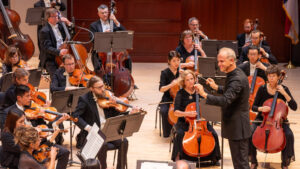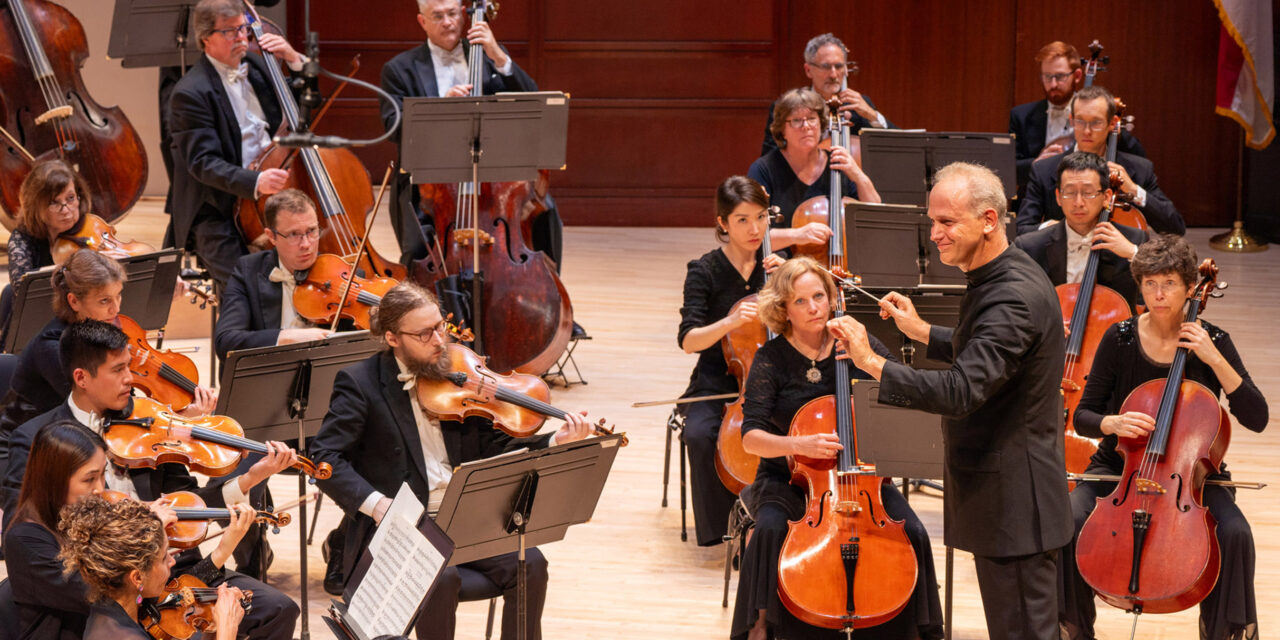
Maestro Carlos Miguel Prieto with North Carolina Symphony players
RALEIGH, NC – “How many of you have never seen Beethoven 5 performed live?” Roughly a quarter of the audience gathered for the North Carolina Symphony‘s pre-concert discussion raised their hands, to which Maestro Carlos Miguel Prieto replied, “That is why we perform the same masterpieces over and over again, because there is always someone—a young person—out there who has not yet heard these great works live.” Courtney Bryan‘s Rejoice, Samuel Barber’s Symphony No. 1, Op. 9, and Beethoven’s Symphony No. 5 in C minor, Op. 67 are three such works that uniquely convey the multi-faceted and often ineffable human condition, despite being written centuries apart. Prieto’s discussion from the stage gave insight into the programming, providing a roadmap that related the three seemingly distinct compositions to each other through their compositional inspirations and lineage. The maestro was engaged with the smaller crowd, telling anecdotes and making jokes, and the genuine familiarity added a comradery to the concert hall that many ensembles of high caliber fail to cultivate; the feeling of community lingered as musicians filed onstage and ushers smiled warmly, and when Maestro Prieto returned to greet the audience at large, it felt like being welcomed by an old friend.
Courtney Bryan’s piece Rejoice, commissioned by the Louisiana Philharmonic in 2019 and dedicated to her family, contains distinct religious connotations garnered from her personal experiences in New Orleans. The composition takes inspiration from Philippians 4:4-7, and the verse’s reverential sentiment to “Rejoice in the Lord always; again, I will say, rejoice” was unmistakable throughout the work. Combining techniques from jazz, sacred, and classical music, Rejoice provided a soundscape fitting for both a sanctuary and a Southern afternoon. Auxiliary percussion emulated distant trolley bells and provided overtones for the initial violin melodies to rest on, emerging from ambient tremolo in the celli and bassi and harmonic foundation in the piano and brass. Bryan’s orchestration allowed for sonorities to bloom without abruption; countermelodies from the harp and piano added texture while the violin lines were enhanced by the incredibly clear timbre of the piccolo. The compositional inspiration from both classical and jazz styles was evident, and aspects of harmony and melody throughout the winds reminded me of Venus from Gustav Holst’s The Planets, though always uniquely in Bryan’s style. As entrances across the stage emerged, I was thoroughly impressed with how the ensemble maintained cohesiveness—fractal melodies never seemed misplaced, and the ebb and flow of phrase was masterfully executed by controlled dynamic and articulation. Declamatory statements added intentional contrast while still blending with the established material, and the trajectory of intensification throughout the work was entirely organic. The orchestra members were clearly engaged through eye contact and unified movement, and any experimental techniques, such as prolonged glissandi or pitch bending, were executed with the same care and conviction as anything else in the classical canon. As the last notes reverberated throughout the hall, the audience sat in appreciative silence before applauding.
Written at age 25, Barber’s Symphony No. 1, Op. 9, is an uninterrupted four-movement work whose inspiration can be traced back through 19th and 18th century Romanticism. During the pre-concert talk, Maestro Prieto discussed how “the reason [these works] are masterpieces is because of their mystery” and how a great composer has the ability to “say a lot with a great motif.” The opening theme of the symphony is the basis for the entire twenty-minute work, and Prieto expanded on Barber’s inspiration from the use of four-note-motifs of both Brahms’s Symphony No. 4 and Beethoven’s Symphony No. 5. The maestro also elaborated on the impact made by Jean Sibelius’s own through-composed Symphony No. 7, written ten years prior to Barber’s, stating that the American composer’s simplicity and romanticism had a similar coherence to the Finnish work. The piece begins confidently with timpani and brass calls, and the lush violin and woodwind theme enters to soar above cinematically. Ostinati maintained energy underneath the chorales, and the orchestra breathed as one entity from the downbeat. Transitioning into the scherzo was almost uncertain, but the eighth notes locked in across the sections after a few bars and stayed connected throughout the rest of the fast variation. As hemiolas and syncopations were passed around, Prieto’s conducting stayed compact and direct, guiding the phrase when needed but otherwise letting the natural momentum of moving lines take care of itself. Sixteenth-note flourishes popped in and out of the winds and strings and the dynamic swells were driven by the rhythmic motor. Huge kudos to individual wind lines, such as the bassoon and clarinet, for maintaining rhythmic and musical consistency during their more exposed moments; the transition between tutti and solo provided great continuity between the energetic scherzo and the lyrical andante. The English horn solo emerged out of the previous cacophony and floated above muted horns while the harp added harmonic accentuation. Prieto conducted the slow section without a baton, gently guiding the overarching phrase, and the string section executed the quintessential sound of Barber’s open sonorities with effortless grace. The culmination of themes in the final Passacaglia was effective through the balance of lower harmonies and rhythmic undercurrents across the ensemble, driving the piece to its grandiose yet somber end. After acknowledging the audience, Prieto facilitated section bows and even walked back to the wind section to shake hands with the principal players.
The piece that needs no introduction, Beethoven’s Symphony No. 5, has become a pillar in both classical music and popular culture. Maestro Prieto said before the concert that “when you hear the first four notes, played fortissimo by an orchestra of this caliber, it changes you,” and as many times as I’ve heard and played this work, I can’t help but agree. Prieto took all four movements attacca, which I found to be incredibly effective; not only did it make musical sense with Beethoven’s material, it provided a definite correlation to the Barber played in the first half. Beginning instantly after the applause died off, the North Carolina Symphony presented the iconic work with unified command and comfort as the maestro conducted from memory. Despite being such a seminal work, there are countless renditions of the Fifth Symphony; many remain effective even in their uniqueness, but I found Maestro Prieto’s interpretation to be one of the most compelling I’ve had the privilege of hearing. The first movement was energetic without feeling rushed, yet while each phrase had release, there was never a pause too long; the orchestra exemplified forward momentum and stately grandeur as one. The development’s second theme had a cheeky feeling and I quite enjoyed how subito dynamic contrasts accentuated the harmonic material. The continuation of the first movement into the second was fantastic, and it emphasized how the opening cello melody directly develops out of the previously established Fate Motif. The moving lines of the variations flowed around the stage and the blending between sections was always full without being overpowering; transitions to softer moments of harmonic intrigue were given care while still maintaining the overall continuity, and I commend Prieto’s intentionality with phrasing. The third movement’s sneaky opening gave way to concise precision in the brass as the horns, and later the violins, pontificated the Motif. The transition into the fugue was seamless as the celli and bassi took over the demonstrative theme with running sixteenths and as the material was passed around the ensemble, I was exceptionally impressed with the dynamic control in the lower strings’ softer moments. The balance between the bassoon and pizzicato transitioning out of the fugue was perfect and propelled the simmering energy into the arrival of the triumphant finale. The opening chords were grandiose, and it was immediately evident how comfortable and victorious the entire orchestra felt. The second violins and violas had tangible energy with their rhythmic motor, and I saw several players grinning at one another. The piccolo and horns added crisp layers to the bustling string parts and crucial accents or syncopations were indicated by the ensemble as a whole. The coda was joyous, and it seemed as though the maestro’s palpable elation would bounce him off the podium. The audience erupted into a standing ovation as the last note rang surprisingly delicately, and Maestro Prieto’s pride in his colleagues was made abundantly clear through multiple bows, soloist acknowledgements, and handshakes. Bravi tutti to a phenomenally cohesive and inspiring concert. I look forward to the continued blend of current and canonized compositional achievements.











